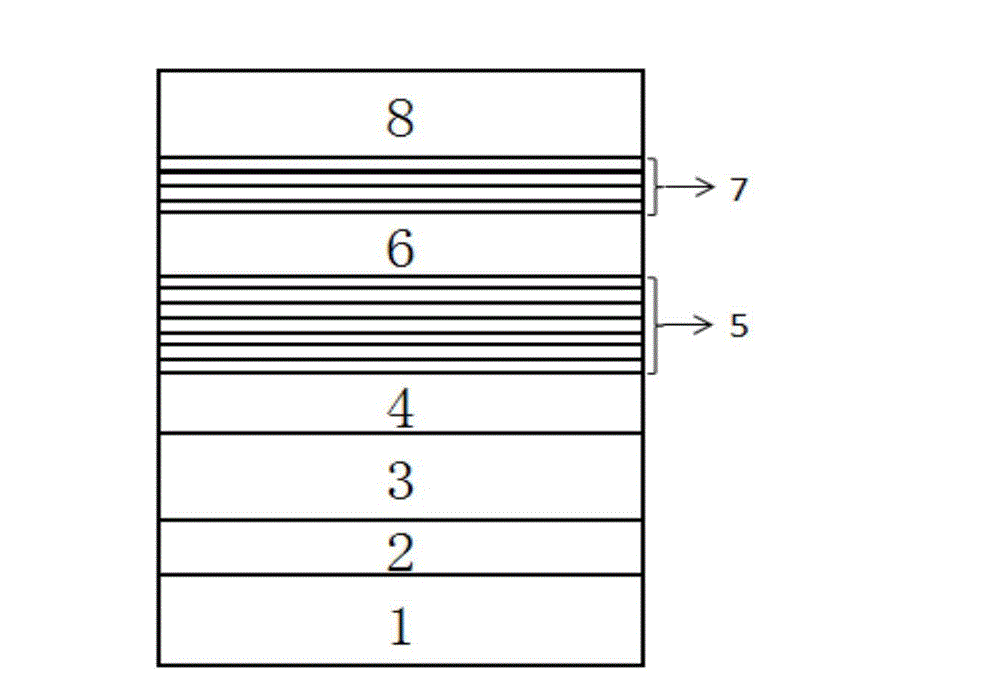LED extension structure with P type superlattice and preparation method thereof
An epitaxial structure and superlattice technology, applied in the field of optoelectronics, can solve the problems of lattice mismatch epitaxial wafer breakage, low luminous efficiency, trapped holes, etc., achieve small lattice mismatch, increase hole concentration, and improve crystal quality effect
- Summary
- Abstract
- Description
- Claims
- Application Information
AI Technical Summary
Problems solved by technology
Method used
Image
Examples
Embodiment 1
[0041] Embodiment 1. An LED epitaxial structure with P-type superlattice and its preparation method.
[0042] See structure figure 1 , taking the preparation of a P-type superlattice structure on a silicon carbide substrate by metal-organic chemical vapor deposition as an example, including the following steps:
[0043] (1) The silicon carbide substrate 1 is placed in the reaction chamber of a metal organic chemical vapor deposition (MOCVD) device, heated to 1050° C. under a hydrogen atmosphere, and processed for 15 minutes.
[0044] (2) An aluminum nitride nucleation layer 2 is grown on a silicon carbide substrate 1 at a growth temperature of 1000° C., a thickness of 150 nm, and a growth pressure of 50 torr.
[0045] (3) A non-doped gallium nitride layer (buffer layer) 3 is grown on the aluminum nitride nucleation layer 2 at a growth temperature of 1100° C., a growth thickness of 2 μm, and a growth rate of 2 μm / h.
[0046] (4) N-type gallium nitride 4 is grown on the galliu...
Embodiment 2
[0053] See structure figure 1 , taking the preparation of a P-type superlattice structure on a sapphire substrate by metal-organic chemical vapor deposition as an example, including the following steps:
[0054] (1) The sapphire substrate 1 is put into the reaction chamber of the metal organic chemical vapor deposition furnace (MOCVD) equipment, heated to 1000° C. under a hydrogen atmosphere, and processed for 12 minutes.
[0055] (2) An AlGaN nucleation layer 2 is grown on a sapphire substrate 1 at a growth temperature of 900° C., a thickness of 120 nm, and a growth pressure of 70 mbar.
[0056] (3) A non-doped GaN layer (buffer layer) 3 is grown on the AlGaN nucleation layer 2 at a growth temperature of 1100° C., a growth thickness of 2 μm, and a growth rate of 2 μm / h.
[0057] (4) N-type gallium nitride 4 is grown on the gallium nitride buffer layer 3, and the silicon doping concentration is 4×10 18 / cm -3 , with a thickness of 2 μm. The growth temperature is about 900°...
Embodiment 3
[0064] See structure figure 1 , taking the preparation of a gallium nitride-based light-emitting diode containing a P-type superlattice on a sapphire substrate as an example, including the following steps:
[0065] (1) The sapphire substrate 1 is put into the reaction chamber of the metal organic chemical vapor deposition furnace (MOCVD), heated to 1000° C. under a hydrogen atmosphere, and processed for 20 minutes.
[0066] (2) Growing gallium nitride nucleation layer 2 on sapphire substrate 1 . The growth temperature is 600° C., and the thickness is 50 nm. The growth pressure was 300 mbar.
[0067] (3) A non-doped gallium nitride layer 3 is grown on the gallium nitride nucleation layer 2 at a growth temperature of 1050° C., a growth thickness of 1.5 μm, and a growth rate of 3 μm / h.
[0068] (4) N-type gallium nitride 4 is grown on the gallium nitride buffer layer 3, and the silicon doping concentration is 3×10 18 / cm -3 , with a thickness of 2.5 μm. The growth temperatu...
PUM
| Property | Measurement | Unit |
|---|---|---|
| Thickness | aaaaa | aaaaa |
| Thickness | aaaaa | aaaaa |
| Thickness | aaaaa | aaaaa |
Abstract
Description
Claims
Application Information
 Login to View More
Login to View More - R&D
- Intellectual Property
- Life Sciences
- Materials
- Tech Scout
- Unparalleled Data Quality
- Higher Quality Content
- 60% Fewer Hallucinations
Browse by: Latest US Patents, China's latest patents, Technical Efficacy Thesaurus, Application Domain, Technology Topic, Popular Technical Reports.
© 2025 PatSnap. All rights reserved.Legal|Privacy policy|Modern Slavery Act Transparency Statement|Sitemap|About US| Contact US: help@patsnap.com

